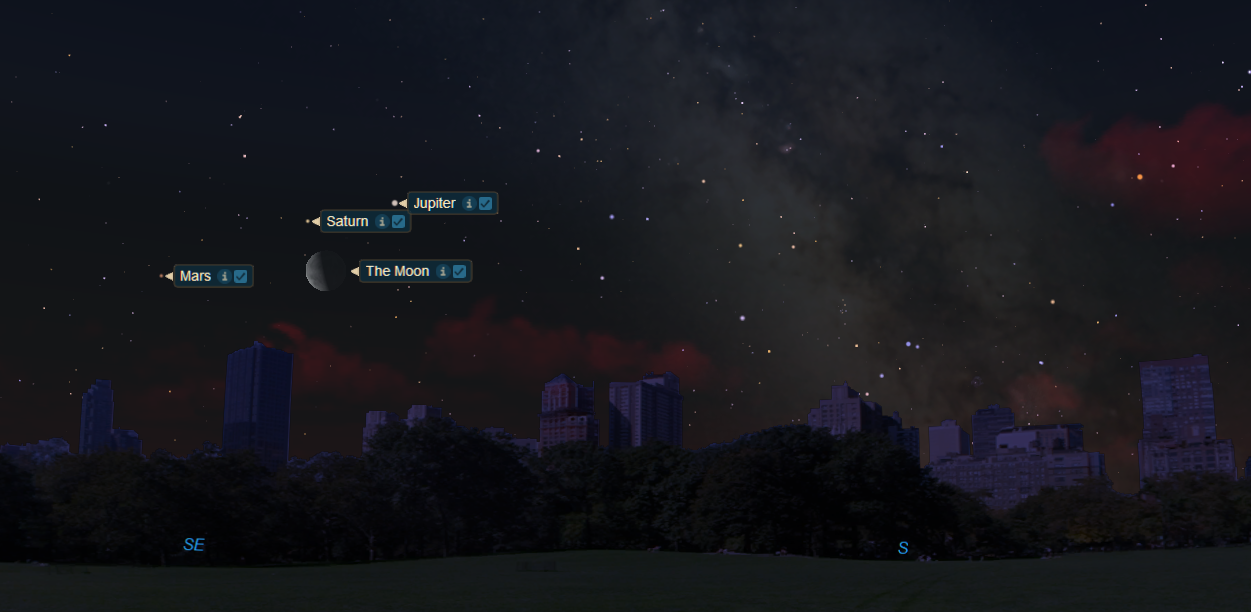
The predawn hours this week will sparkle as Jupiter, Saturn and Mars dance around the moon on consecutive mornings.
On Tuesday morning (April 14), the moon will be moving toward the largest planet in our solar system, giant Jupiter. Then, on Wednesday (April 15), the moon will meet up with the ringed wonder of our planetary system, Saturn. Finally, on Thursday (April 16), it will be the turn of the god of war, Mars, to have a summit meeting with the moon.
Of course, such alignments are all just a matter of perspective. Our moon will be about 243,000 miles (390,000 kilometers) away from Earth during these encounters, while Mars stands 125 million miles (200 million km), Jupiter is 473 million miles (761 million km) distant, and Saturn is even farther out in space at 936 million miles (1.51 billion km).
Related: Here's what to see in the night sky while you're stuck at home
More: The brightest planets in April's night sky: How to see them (and when)
Moon and Jupiter
Early Tuesday morning at around 3 a.m. local daylight time, look low toward the southeast horizon and you will see the rising of the "half," or last-quarter, moon. Located about 8.5 degrees to its lower left and shining brilliantly will be Jupiter. By around 5 a.m., both the moon and the planet will be considerably higher up in the south-southeast part of the sky. (Reminder: Your clenched fist held at arm's length covers about 10 degrees of sky.)
If you have a telescope, the best time to check out Jupiter will be just after the break of dawn, when the planet will appear at its highest above the horizon. The gas giant provides a feast of detail, especially in moderately large telescopes, and provides at least a few grey cloud belts (not to mention its four large Galilean moons) even for small telescopes.
In fact, if you check out Jupiter Tuesday morning, you'll see all four moons "strung out" in a nearly straight line on one side of the big planet. They are, in order of distance from Jupiter: Io, Europa, Ganymede and Callisto. Add our own moon and you'll have five for the price of one!
Get the Space.com Newsletter
Breaking space news, the latest updates on rocket launches, skywatching events and more!
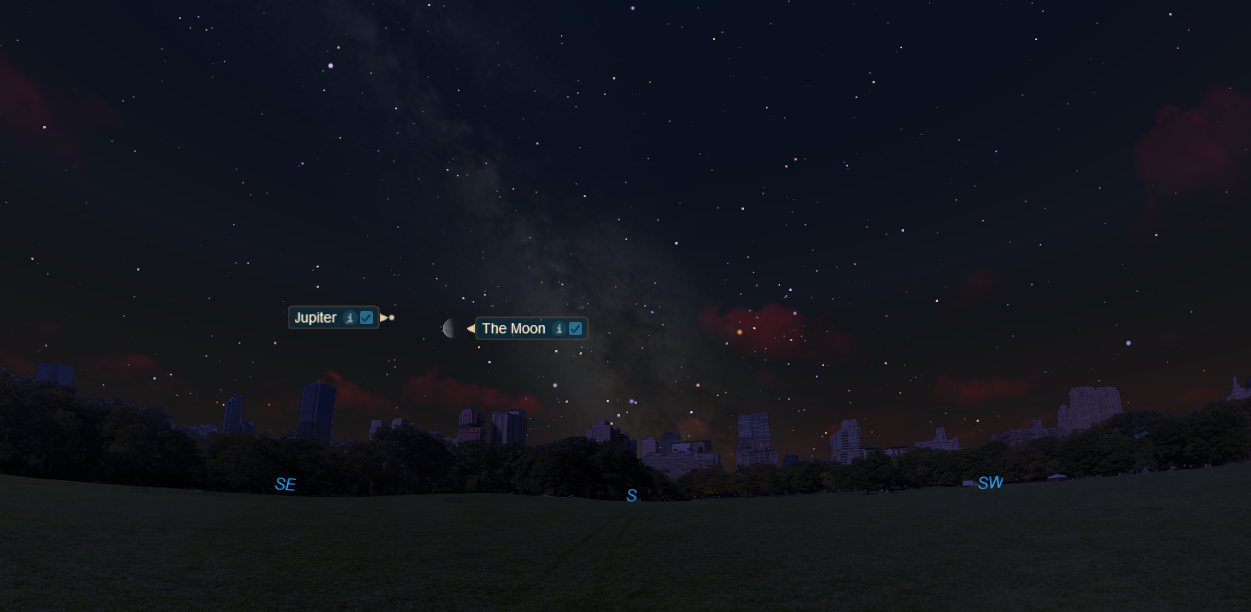
Jupiter will come close to the moon in the early hours of April 14, 2020.
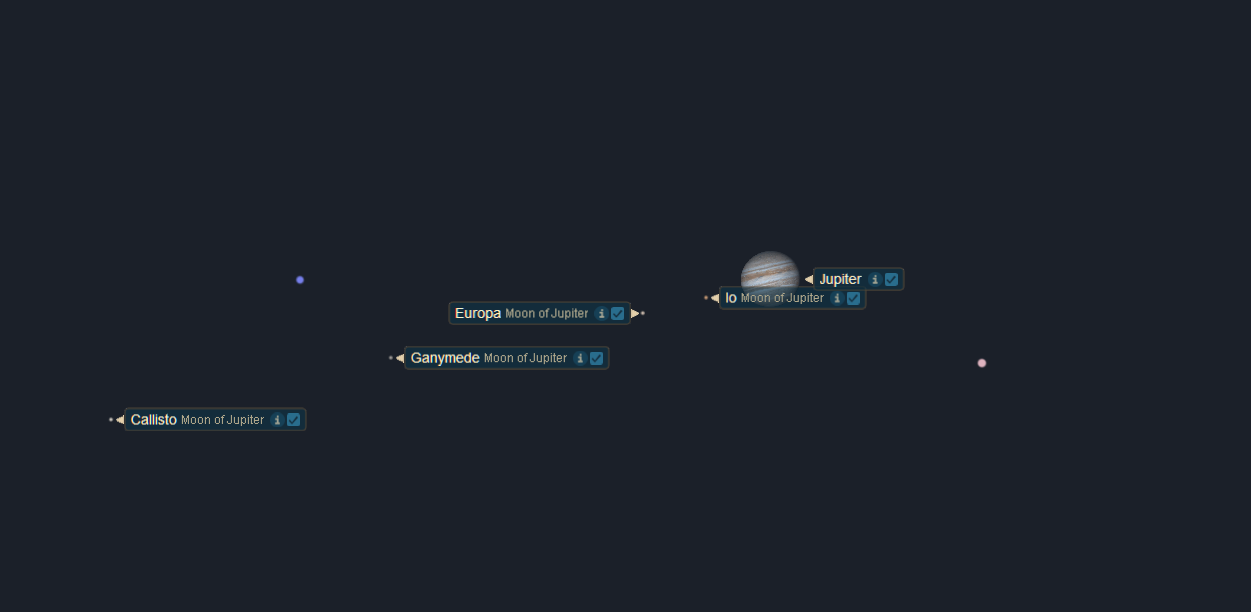
Jupiter and its moons in a "string of pearls" formation on April 14, 2020.
Moon and Saturn
On Wednesday, if you can stay up until the last lonely hours before dawn again, you'll see a slightly slimmer, waning crescent moon rise low in the southeast at 3:30 a.m.; sitting about 3 degrees to its upper right will be a star-like object shining with a sedate yellowish-white tint. That will be Saturn.
At a magnitude of -2.2 Jupiter stands out like the proverbial sore thumb, even when close to the bright moon. Saturn, at magnitude +0.6, is about 13 times dimmer. The ringed planet might not immediately call attention to itself, although it will be the brightest object in the moon's vicinity Wednesday morning. You might notice that Jupiter, Saturn and the moon combine to make a rather eye-catching isosceles triangle, with the lengths of the Jupiter/Saturn and Jupiter/moon "legs" equal to 5.5 degrees, while the Saturn/moon "base" is 3 degrees wide.
As with Jupiter, you should wait until 5 a.m. to check Saturn out with a telescope, although the planet will appear lower than Jupiter and as such its image might appear a bit distorted due to atmospheric turbulence. The great ring system is tilted 22.5 degrees to our line of sight and can be glimpsed in a small telescope or high-powered binoculars with magnifications as low as 25 power.
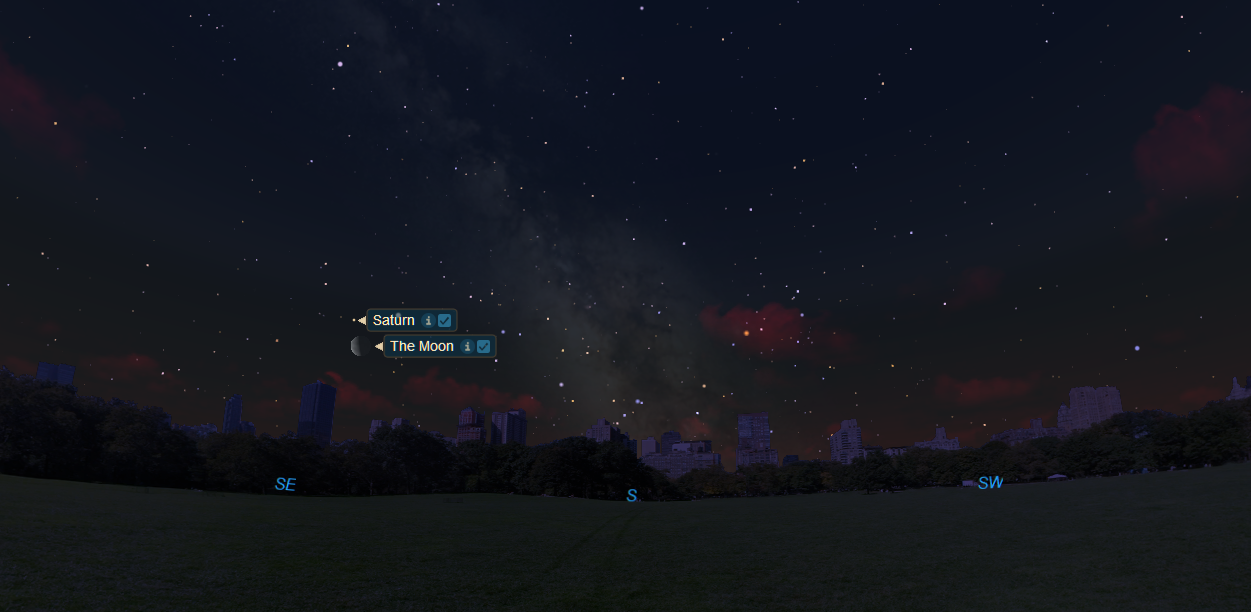
Moon and Mars
Finally, on Thursday morning, the moon will visit Mars, passing 3.5 degrees below and to the left of the Red Planet. Start looking low to the east-southeast horizon soon after 4 a.m. as the pair slowly ascends.
Have you noticed how much brighter Mars is becoming as it continues to approach Earth? Currently, Mars shines at magnitude +0.6, but it will increase nearly 20-fold in brightness between now and early October, as it comes roughly 500,000 miles (800,000 km) closer to us each day.
Related: Best night sky events of April 2020 (stargazing maps)
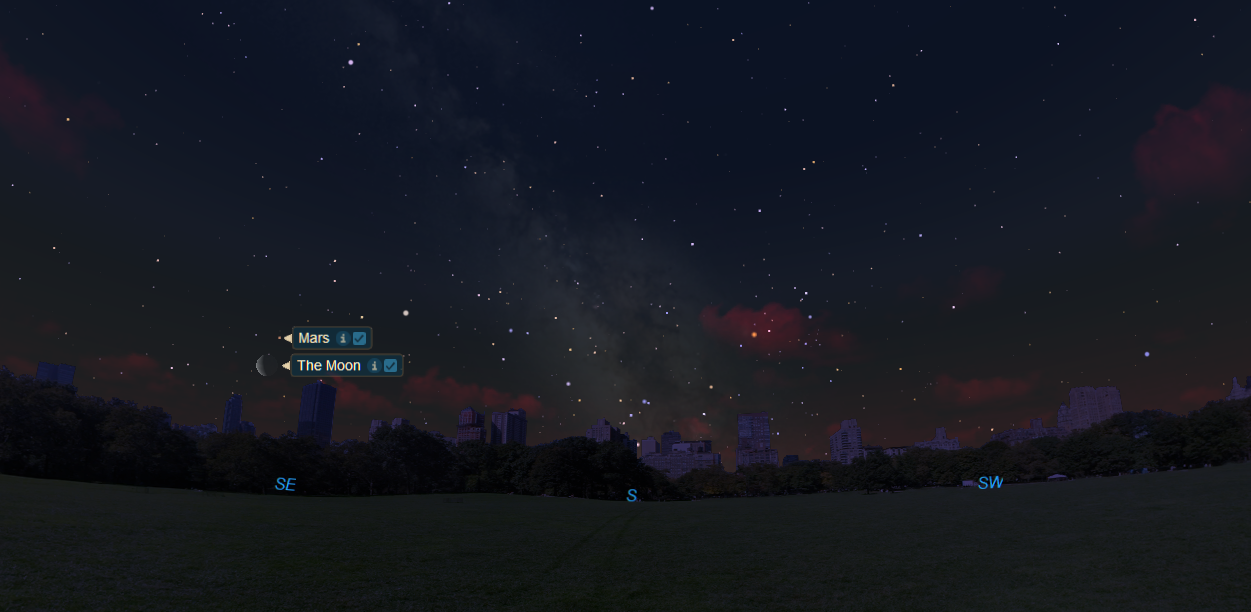
Looking ahead to a once-in-a-lifetime event
As we have previously noted, Jupiter and Saturn are currently separated by 5.5 degrees in our sky, but in the coming months, this situation is going to change dramatically. At roughly 20-year intervals, Jupiter and Saturn engage in a conjunction, coming quite close to each other in Earth's sky, after Jupiter's faster motion around the sun allows it to overtake Saturn in our sky.
The last time this happened was in May 2000; later this year it will happen again. Usually, when Jupiter and Saturn "meet," they approach to within a degree or two of each other in our skies. But what will happen in December will be nothing short of extraordinary. On Dec. 21, Jupiter and Saturn will come to within six arc minutes, or 0.1 degree of each other.
That's just one-fifth the apparent diameter of the moon. It will be by far the closest that these two planets have appeared relative to each other since the year 1623 — and so close together that if you use a telescope and a high-power eyepiece, you will be able to fit both planets in the same field of view!
- Best night sky events of April 2020 (stargazing maps)
- The 10 must-see skywatching events to look for in 2020
- Night sky, April 2020: What you can see this month [maps]
Joe Rao serves as an instructor and guest lecturer at New York's Hayden Planetarium. He writes about astronomy for Natural History magazine, the Farmers' Almanac and other publications. Follow us on Twitter @Spacedotcom and on Facebook.
OFFER: Save 45% on 'All About Space' 'How it Works' and 'All About History'!
For a limited time, you can take out a digital subscription to any of our best-selling science magazines for just $2.38 per month, or 45% off the standard price for the first three months.
Join our Space Forums to keep talking space on the latest missions, night sky and more! And if you have a news tip, correction or comment, let us know at: community@space.com.

Joe Rao is Space.com's skywatching columnist, as well as a veteran meteorologist and eclipse chaser who also serves as an instructor and guest lecturer at New York's Hayden Planetarium. He writes about astronomy for Natural History magazine, Sky & Telescope and other publications. Joe is an 8-time Emmy-nominated meteorologist who served the Putnam Valley region of New York for over 21 years. You can find him on Twitter and YouTube tracking lunar and solar eclipses, meteor showers and more. To find out Joe's latest project, visit him on Twitter.










